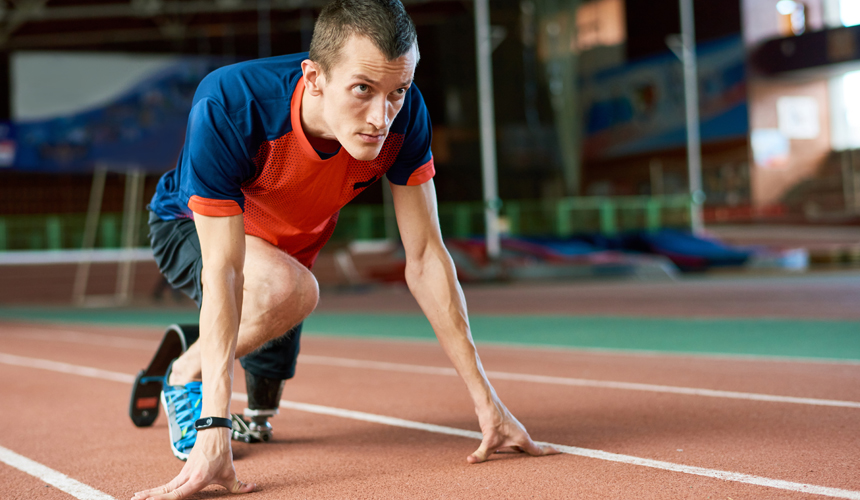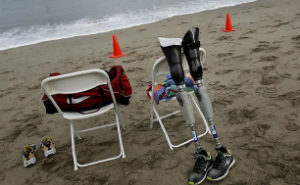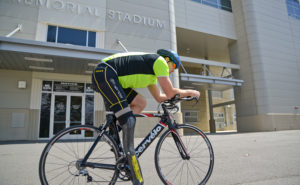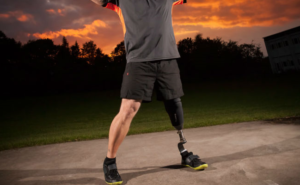The loss of a limb can seem discouraging to those hoping to live the same active lifestyle. However, having a prosthetic device does not mean you cannot compete athletically. With today’s prosthetics technology, you can still dominate competitive sports.
Athletes with prosthetic devices
Many high-profile athletes before you have enjoyed successful careers and inspired others to stay active. If you are an athlete with a prosthetic device, then consider these amazing athletes with prosthetic devices who have achieved their goals!
Jeremy Campbell
Jeremy Campbell was born without his right fibula. He was the first disabled athlete to launch a discus 60 feet, and then set a Paralympic world record for a throw of 62.18 meters.
Kelly Cartwright
Kelly Cartwright was diagnosed with an aggressive form of cancer of the knee, resulting in her right leg above the knee being amputated. With her prosthetic leg and rehabilitation, she began to run. She later finished in 6th place in the 100-meter event at the 2008 Beijing Paralympics. She also set and broke her own record in the 100m event and long jump in the 2012 London Paralympics. She has climbed Mt. Kilimanjaro and danced on Australia’s Dancing With the Stars.
Amy Purdy
Amy Purdy contracted bacterial meningitis and had a double amputation below the knee at 19 years old. Instead of giving up snowboarding, because there were no prosthetics available at the time, she built her own and continued to snowboard.
She competed and won medals at the 2011 World Cup in France and Canada, the 2012 Para-Snowboard World Championships, the 2013 U.S. Paralympics Snowboard Cross National Championships, and the 2014 Paralympic Winter Games. She also co-founded the Adaptive Action Sports to help those experiencing physical challenges participate in high-action sports, appeared on US’s The Amazing Race and Dancing with the Stars, and so much more.
Aimee Mullins
Aimee Mullins was born without fibula bones in both legs. She had a double amputation of both legs below the knee when she was one year old. She learned to walk with prosthetics by two and is now a successful Paralympic athlete.
Scott Schroeder
Scott Schroeder was a U.S. soldier who was caught in a roadside bomb attack in Afghanistan. The bombing took both of his legs and one arm. Wearing two prosthetic legs and one arm, he still enjoys scuba diving, and many know him for his underwater explorations.
Chris Madison
Chris Madison underwent a below-the-knee amputation. Since then, he has competed in the Ironman Triathlon and has run many marathons.
Mike Schultz
Mike Schultz lost his leg in a snowmobiling accident. Instead of giving up competing in the X Games, he created his own prosthetic to allow for the range of motion he needed to compete in snowmobile and motocross competitions.
His design is called the Moto Knee and Versa Foot that allow for participation in extreme sports. He won silver and gold in the Adaptive Motocross Games just two years later.
Which prosthetics are right for me?
New technology and materials have allowed athletes with prosthetics to enjoy sports, set records, and beat those records many times over. Check out the latest in prosthetic technology.
Blades
Blades are curved lower-extremity prosthetic made of carbon fiber with flexibility and traction, allowing runners to sprint at high speeds. These are one of the more well-known prosthetics, made popular by runner Oscar Pistorius and designed by our very own Francois Van Der Watt, who now practices advanced prosthetics at Horton’s Orthotics & Prosthetics in Fort Smith, Arkansas.
Moto Knee & Versa Foot
This design is created for lower-extremity as well, allowing for range of motion and impact with absorbers and spring actions. This system is used most often for participation in extreme sports.
Upper-limb prosthetics
Many specially-modified upper-limb sports prosthetics, such as the Viau system (swimming), the Eagle (golfing), the Pinch Hitter (baseball), the Power Play (hockey), or hooks (bicycling) combine advanced technology with hybrid materials, allowing athletes the use of fingers, elbows, arms, and play in their sports of choice.
Bionic sports prosthetics
Bionic prosthetics are the most advanced and responsive prosthetics. Bionic prosthetics attempt to mimic natural limbs. Currently, bionic hands, arms, and legs work by picking up electrical signals from the stump and using practice and concentration to control a movement.
Choosing the correct prosthetics
Every amputation situation is different. In order to find the appropriate prosthetics for your sporting needs, you should meet with a professional from Horton’s Orthotics & Prosthetics to help design a prosthetic that will allow you to continue playing sports.
Whether you are active as a swimmer, basketball player, cyclist, runner, fisherman, skier, or any of the other sports, you can accomplish your goals with the proper prosthetics, including bionic sports prosthetics.
For more information
Do not let a prosthetic keep you from an active lifestyle. For more information, contact Horton’s Orthotics & Prosthetics at (501) 683-8889 to speak to an advanced sports prosthetics expert.




Leave a Reply